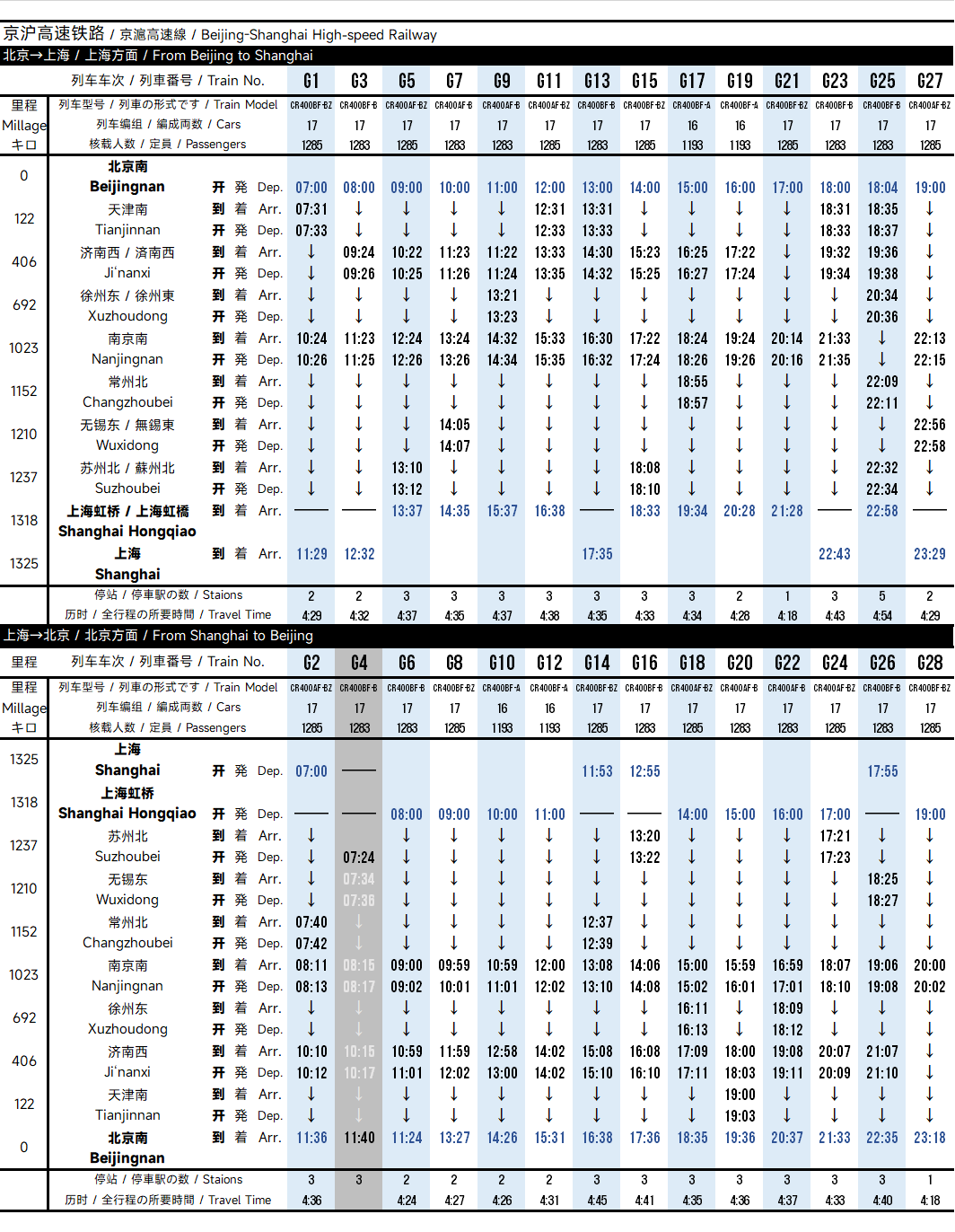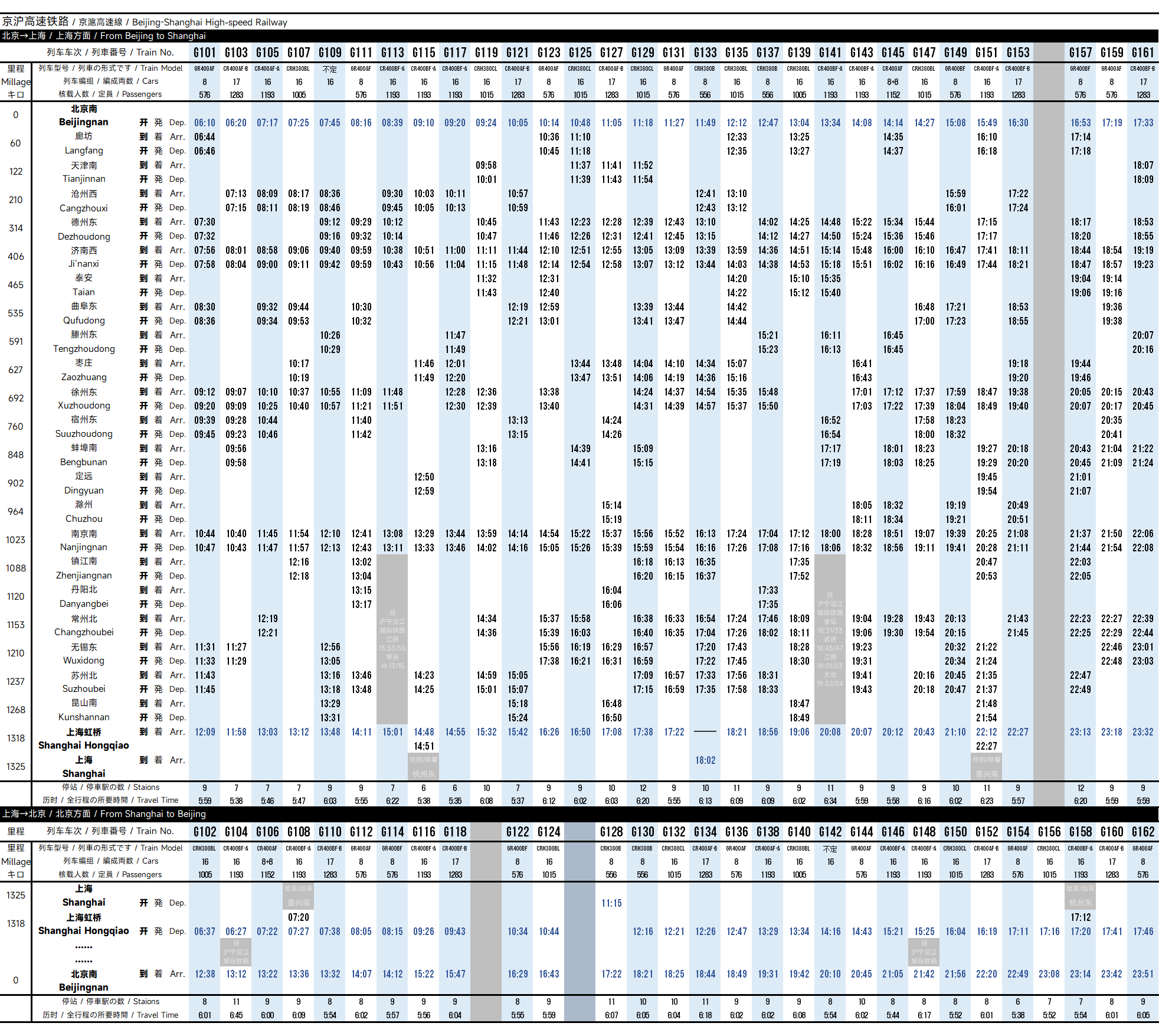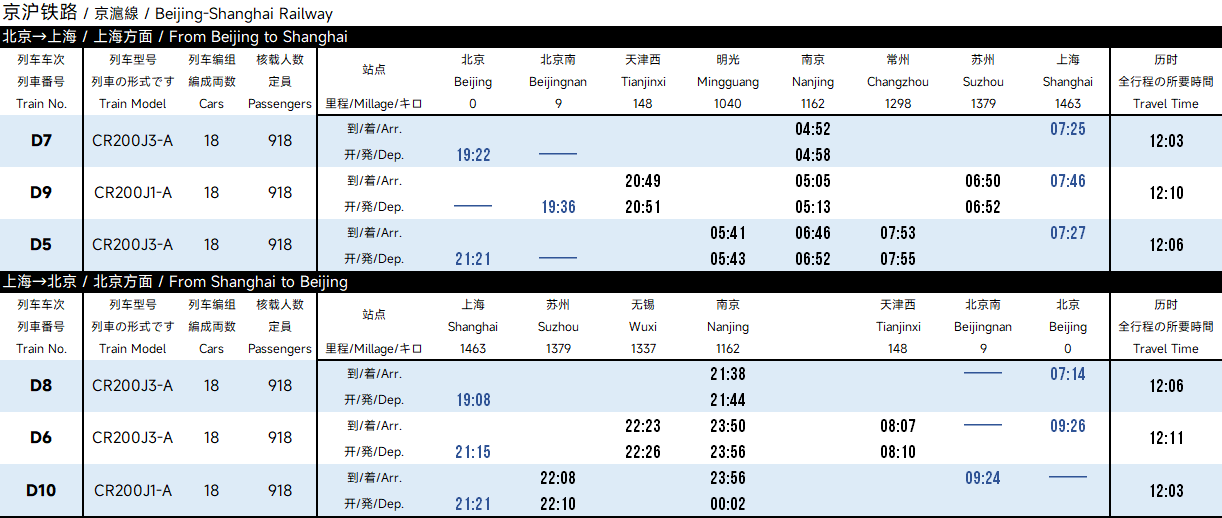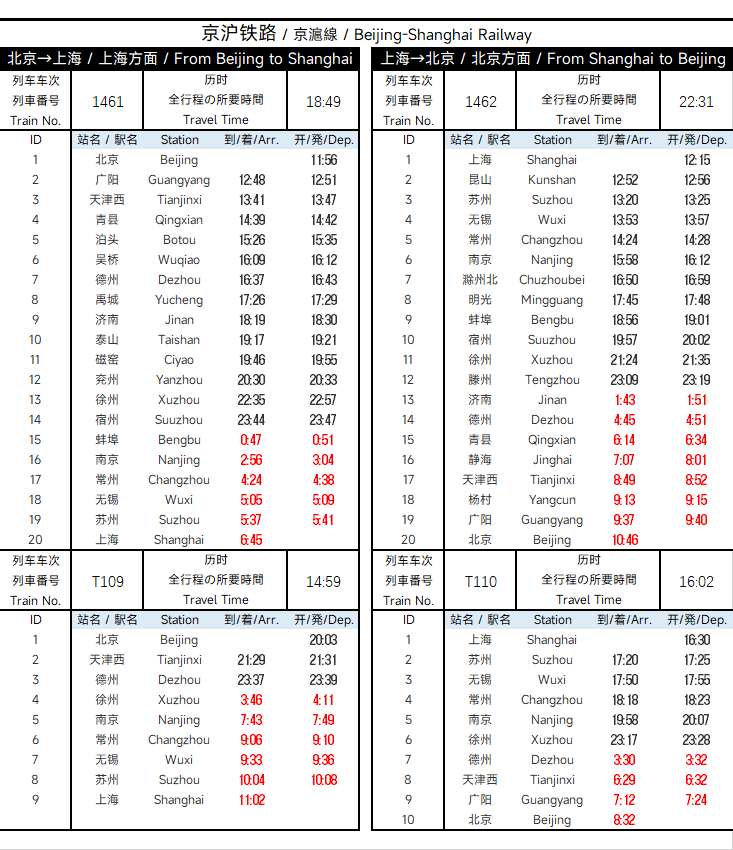Beijing and Shanghai are economically developed regions in China, with close exchanges and relatively developed railway transportation services. Especially, the Beijing-Shanghai high-speed railway connecting the two cities has become one of the most vigorous passenger flow lines in high-speed railway system in China, with hundreds of trains running on the Beijing-Shanghai high-speed railway every day. About 40 run the entire length of the Beijing-Shanghai high-speed railway, while the traditional Beijing-Shanghai railway still provides passenger service. From the center of the city to the center of another, taking a high-speed train is often faster than taking a flight, because airport check-in and security check are cumbersome, and airports, especially in Beijing, are far from the center of the city. It also relatively time-consuming to leave the airport after landing. The variety of trains and seats between Beijing and Shanghai, the price and experience are different, and this page will show you how to travel between Beijing and Shanghai by Trains.
There are currently two direct rail lines linking between Beijing and Shanghai, one of them is the Beijing-Shanghai railway, which began service in 1908, but much of its infrastructure was rebuilt between 2004 and 2007 to making it possible to run at 200 km/h (~124 mph) for most sections. At present, the passenger trains running at a maximum speed of 160 km/h (~99 mph) , and the mileage between Beijing and Shanghai is 1,463 km (~909 miles). The other is the Beijing-Shanghai high-speed railway, which opened in 2011 with a total length of 1,318 km (~819 miles). The design speed of 380 km/h (~236 mph) and currently trains run at 350 km/h (~217 mph).
The Beijing-Shanghai Railway and the Beijing-Shanghai High-speed Railway mainly undertake long-distance train service, and there will be other lines to provide short-distance train service between some of the closely connected nearby cities where passenger travel demand is strong. For example, there are five rail lines between Beijing and Tianjin, and five lines also between Shanghai and Nanjing. In addition, there are a small number of trains between Beijing and Shanghai that travel on other lines between Nanjing and Shanghai.
There are a variety of train services between Beijing and Shanghai, and there are diverse seats and sleepers for passengerd to choose. The highest and lowest fares can vary by a factor of 10, but all trains have air conditioning to ensure a suitable temperature inside the car, and all provide toilets.
Trains on the Beijing-Shanghai high-speed Railway
There are two main types of trains running on high-speed railways.
One type of them is the high-grade trains, which have a number G with one or two digits, these trains all run at a maximum speed of 350 km/h, takes about 4 hours 18 minutes to 4 hours 45 minutes within 1-3 stations during the whole trip. Such trains fare is usually non-discounted. A second-class ticket from Beijing South Railway Station to Shanghai Hongqiao Station costs 662 yuan (about 84 euros), while 667 yuan to Shanghai Railway Station . The most exclusive seats cost 2,318 yuan (295 euros) for the entire ride.
The other type of train has three digits beginning with 1 after letter G, these trains normally run at a maximum speed of 310km/h, the whole journey takes 5.5-6.5 hours, there will be a certain discount, the lowest price of second-class seats is 526 yuan (about 67 euros).
Trains on the Beijing-Shanghai regular Railway provide sleepers
There are also two types of trains running on traditional railway.
There are the sleeper EMU trains with the number beginning with D that run at night on the traditional Beijing-Shanghai Railway (Service started at 1908), which take about 12 hours and provide a relatively adequate sleep time, the ticket price is arrange in 673 to 965 yuan (85 to 122 euros) depending on the sleeper type. During most off-peak days, 20-30% off are usually applied, and tickets range from about 474 to 680 yuan (60 to 68 euros). These trains run at a maximum speed of 160 km/h.
In addition, there are also traditional rolling stock trains that provide only basic services, which take longer to run but thge price are cheaper, with the lowest class of seats costing 156.5 yuan (less than 20 euros) for the full journey.
The vast majority of Beijing-bound and Shanghai-bound trains depart and arrive at Beijingnan (Beijing South) Railway Station, with only a few departing and arriving at Beijing Station.
Shanghai also has two stations providing train service direct to Beijing, which named Shanghai Station and Shanghai Hongqiao Station, where about one-fifth of the trains depart and arrive at Shanghai Station, while the rest depart and arrive at Shanghai Hongqiao Station.
Train tickets are real-name, and all seats are Reserved Seat. If special seats on certain special trains need to be designated, they need to be purchased some days in advance. Extra trains are added during peak passenger traffic.
Other content please click for details.
The Beijing-Shanghai high-speed railway usually uses the highest class and newest trains, which are basically put into use within five years, the in-car broadcast and display content are provided in Chinese and English, and AC 220V power sockets and USB-A charging sockets are provided. High-level trains have a number G with one or two digits, these trains all run at a maximum speed of 350 km/h (~217 miles), takes about 4 hours 18 minutes to 4 hours 45 minutes within 1-3 stations during the whole trip. Such trains fare is usually not discounted. A second-class ticket from Beijing South Railway Station to Shanghai Hongqiao Station costs 662 yuan (about 84 euros), while a ticket to Shanghai Railway Station costs 667 yuan.

These type of trains have a number in three digits beginning with 1 after letter G, these trains normally run at a maximum speed of 310 km/h (~192 mph), the whole journey takes 5.5-6.5 hours, there will be a certain discount, the lowest price of second-class seats is 526 yuan (about 67 euros). In the event of delay, such trains may also operate at speeds exceeding 310 km/h but not exceeding 350 km/h to recover the delayed time. There are a variety of trains, some of which use trains that are more than 10 years old, but these trains can also provide relatively complete service.

EMU trains mainly provide business class, first class and second class seats, early part of the train to provide box seats. Most of the trains running between Beijing and Shanghai are relatively new and the experience is relatively good.
There are 12 models of EMU trains running between Beijing and Shanghai on High-speed rail, they are the 「复兴号」 trains with 8 types in 4 appearance and the 「和谐号」 trains with 4 types in 2 appearance.
「复兴号」 means revival and 「和谐号」 means harmony in Chinese.
The overnight trains with sleepers have a train number starting with D, which runs at night on the traditional Beijing-Shanghai railway, offers four-person private rooms (two layers of bed) and six-person compartments (three layers of bed). the trip takes about 12 hours to ensure a decent amount of sleep, and fares range from about 673 to 965 yuan (85 to 122 euros) depending on the sleeper type and location. During most off-peak hours, discounts of 20-30% are usually applied, and tickets range from about 474 to 680 yuan (60 to 86 euros). The train has a maximum speed of 160 km/h (~99 mph)。These trains also offer a small selection of seats.

There are four-person private lockable rooms (two-level sleeper) and six-person doorless compartments (three-level sleeper), each bed has a USB-A port for charging, and the trains have air conditioning and toilets.
The sleeper EMUs are all CR200J series in color green.
These train tickets are very cheap. Although the speed is relatively slow, it is still very popular with passengers.At present, the traditional trains running between Beijing and Shanghai have two services in each direction. The T109 and T110 have a maximum operating speed of 140 km/h (~87 mph), and the 1461 and 1462 have a maximum operating speed of 120 km/h (~75 mph).

